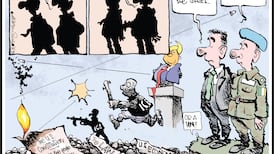If the numbers are to be believed, Sinn Féin is on course to become the largest political party in Ireland – both North and South.
The latest polls from LucidTalk and Behaviour & Attitudes forecast an unprecedented development in the history of the party, as well as that of the island of Ireland, with a nine-point lead in Northern Ireland and a 10-point lead in the Republic of Ireland. With polling indicating that enduring inadequacies in the housing and health systems remain the most pressing issues for the populace, the party kept its think-in this week laser-focused on the Government’s chronic policy deficits.
All polling should be taken for what it is – a window into public perception. Nevertheless, a key trend is emerging that may prove challenging for the Government parties.
As Ireland’s political landscape prepares to be resculpted, one demographic in particular is proving key in hurrying the transformation process along: young people.
LucidTalk’s summer tracker poll highlights a significant generational gap when it comes to political party support, with 49 per cent of 18- to 24-year-olds supporting Sinn Féin, versus only 5 per cent in support of the Democratic Unionist Party (DUP).
Similarly, stark generational divides are repeated in the South, with the latest Behaviour and Attitudes poll indicating that 45 per cent of those aged 34 and under would vote for Sinn Féin, while only 17 per cent and 13 per cent would favour Fine Gael or Fianna Fáil respectively.
Tectonic shifts
The youth vote has been central to Ireland’s recent tectonic shifts away from the social conservatism long associated with the country’s history.
Young voters in particular have been credited with swinging the Yes vote in the 2015 marriage equality referendum, and 90 per cent of under-25s who cast their ballot voted to repeal the Eighth Amendment in 2018. That this cohort is flocking to Sinn Féin is not inconsequential – as there exist few blows more damaging to the integrity of conservative political structures than young people with aspirations for change.
Polling suggests that the youth movement may already be mobilised around another campaign for transformation – a united Ireland. A LucidTalk poll commissioned by BBC Spotlight earlier this year provided a curious insight into the position of young voters on the constitutional debate. Despite no official reunification campaign in place, 50 per cent and 71 per cent of 18- to 34-year-olds in the North and South respectively say they would vote in favour of a united Ireland today.
This information will no doubt bolster Sinn Féin’s case for maintaining its current course. Young voters are proving to be the party’s primary base and, should polls be anything to go on, their support for constitutional change could mean a very different Ireland much sooner than many had predicted.
However, the poll also indicates some potential snags for the party’s unity plan. While young people on both sides of the Border back reunification, they differ on some of the more crucial fine details.
The overwhelming majority of Northern participants support amending the Irish flag and the national anthem, whereas the same age demographic in the Republic of Ireland overwhelmingly opposed changing either.
To have such a high level of support for a united Ireland on principle is remarkable in and of itself. However, the lack of sufficient detail regarding the nature of reunification, and the absence of a space to effectively analyse the subject, leaves considerable ambiguity as to what a united Ireland might truly look like.
Fianna Fáil has sacrificed any credentials as a pro-unity party itself
It is widely accepted that certain portions of the Belfast Agreement contain deliberately ambiguous language, employing vagueness as an intangible tool to encourage amicability, and ultimately reach an accordance. But when it comes to emotive issues concerning national symbols in a united Ireland, well-meaning ambiguity may not cut it.
With only one North-South commonality showing up in the polls – a desire for a reimagined island-wide NHS-style healthcare system – all those advocating for change will need to find more common ground if they hope to see Ireland reunified.
The correlation between young voters supporting both Sinn Féin and a united Ireland will be no surprise to parties in the North, where the cut and thrust of daily politics has long revolved around the constitutional question. However, due to an intrinsically different social and political climate born of a century of independence, the political parties of the Republic of Ireland may encounter more significant challenges.
Pro-unity stance
Fianna Fáil in particular has been so focused on creating a distinction between itself and Sinn Féin’s pro-unity stance that it has, in the process, minimised its own identity and sacrificed any credentials as a pro-unity party itself.
A recent internal review of its electoral performance identified a fixation on Sinn Féin as one of many contributing factors leading to the party’s diminishing support.
The escalating identity crisis for the party took a new turn on Wednesday when Fianna Fáil TD Marc MacSharry resigned from the parliamentary party over the controversy around the appointment of Katherine Zappone as a UN special envoy.
He accused the Government of behaving like an “undemocratic totalitarian regime” after the Taoiseach, Micheál Martin, applied the whip in the no-confidence motion against Fine Gael Minister Simon Coveney.
Ireland’s Coalition Government will grow increasingly determined to cut Sinn Féin’s lead in the polls as we near election day. But it will require more than simply dredging up the less-savoury aspects of the party’s past if they hope to succeed.
Change is what Ireland’s youth demands.












